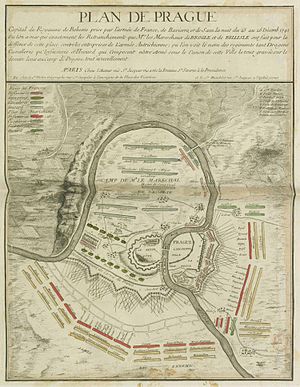Siege of Prague (1742)
| date | June to December 1742 |
|---|---|
| place | Prague |
| output | Austrian partial success |
| Parties to the conflict | |
|---|---|
| Commander | |
| Troop strength | |
| 19,000 infantry and 7,000 horsemen | 27,000 infantry and 17,000 horsemen |
| losses | |
|
? |
? |
The siege of Prague took place from June to December 1742 during the War of the Austrian Succession .
prehistory
After passing through the allied Bavaria, French troops broke into the imperial crown land of Bohemia and occupied Prague on November 26, 1741. As a result of the negotiations initiated with Prussia, the First Silesian War ended on June 11, 1742 with the Peace of Wroclaw . The troops of Duke Charles of Lorraine , which had become free in northern Bohemia, united with the Bohemian military forces under Prince von Lobkowitz and initially pursued the French, who were returning from Protivin to Písek , with light troops to Pilsen . Marshal Victor-François de Broglie's corps fled to Prague via Mirotitz by June 13th . In addition, Lieutenant Field Marshal Joseph Festetics de Tolna had orders to bring his troops through Moravia , while Duke Charles of Lorraine marched via Mauth and Beraun and camped at Slivenetz on the Moldau on June 27th . The French forces in the city were besieged by an overpowering Austrian army . The brother of the Duke of Lorraine, Grand Duke Franz Stephan of Tuscany , formally took over the supreme command of the Austrian army, which had been brought to a strength of 27,000 infantry and 17,000 horsemen. Marshal Broglie was also able to unite in time with other troops from General Belle-Isle in Prague and strengthen himself to 19,000 infantry and 7,000 horsemen who occupied Prague.
procedure
The French had cordoned off the loop on the Vltava with Prague's Lesser Town by means of field entrenchments from Cisařský Ostrov to Smichov and concentrated the entire cavalry behind it , 15 regiments of dragoons, two hussar regiments, 17 regiments of heavy cavalry and seven regiments of infantry . The exit from this pocket was a bridge (today's Libeňský Most), which was secured by three cavalry regiments and one infantry regiment. On the other side of the bridge was a reconnaissance hussar regiment.
The regular siege did not begin until August 16 after the completion of trenches running parallel to the bastions of Sankt Elisabeth and Sankt Norbert.
The main area of action, however, was the advanced field entrenchments in front of Prague's old town, where almost all of the French infantry were concentrated.
The attacks by the Austrians were not very effective, and because of the special geographical location it was not possible to completely enclose the city. Even so, the conditions for the besieged became increasingly difficult.
In September a relief army forced the Austrians to temporarily break off the siege. De Broglie then left the city, command passed to Marshal de Belle-Isle. He still hoped for relief from Marshal Jean-Baptiste Desmarets , who was in the Netherlands with 40,000 men in order to keep the troops of the Elector of Hanover in check. Maillebois united with the Count of Harcourt's corps and marched eastward through Lower Franconia with strong force .
Maillebois' relief army, meanwhile, lacked the necessary resolve to force the advance into Bohemia. On December 16, Belle-Isle was able to withdraw from the fortress with 14,000 men, which the Austrians only noticed on December 18. They immediately closed the possible departure routes, but Belle-Isle maneuvered them and reached Eger under difficult climatic conditions after a ten-day march through the Bohemian Forest .
Prague fell back to the Austrians on January 3, 1743. Belle-Isle had left 6,000 men in Prague, most of them wounded or sick. They accepted the call to surrender and handed over the fortress. They were then granted a deduction with full military honors.
annotation
The map shown is not very precise. Among other things, it is not aligned to the north - it would have to be correctly rotated 90 degrees to the right in order to reproduce a more precise geographical situation.
literature
- Lettre inédite sur le siège de Prague en 1742, par le fils du comte d'Entraignes, seigneur de Saint-Perst. In: Procès-verbaux de la Société archéologique d'Eure-et-Loir. Volume 2. Petrot-Garnier, Chartres 1864, p. 210 ( digitized on Gallica ).
- Johann Baptist Schels : History of the countries of the Austrian imperial state. Volume 9. J. G. Heubner, Vienna 1827, p. 358 ff. ( Full text in the Bavarian State Library ).
Web links
- Siège de Prague (1742). Journal critique d'un lieutenant-ingénieur dans l'armée autrichienne devant Prague (full text in Google Books ). Tendler, Vienna 1867
- Alain Chardonnens, Alexandre Dumas: Le siège de Prague de 1742. In: Sept.info
- Des lettres de 1741 et 1742 relatant le siège de Prague par des soldiers français. In: Blog Histoire Géo. October 14, 2015
